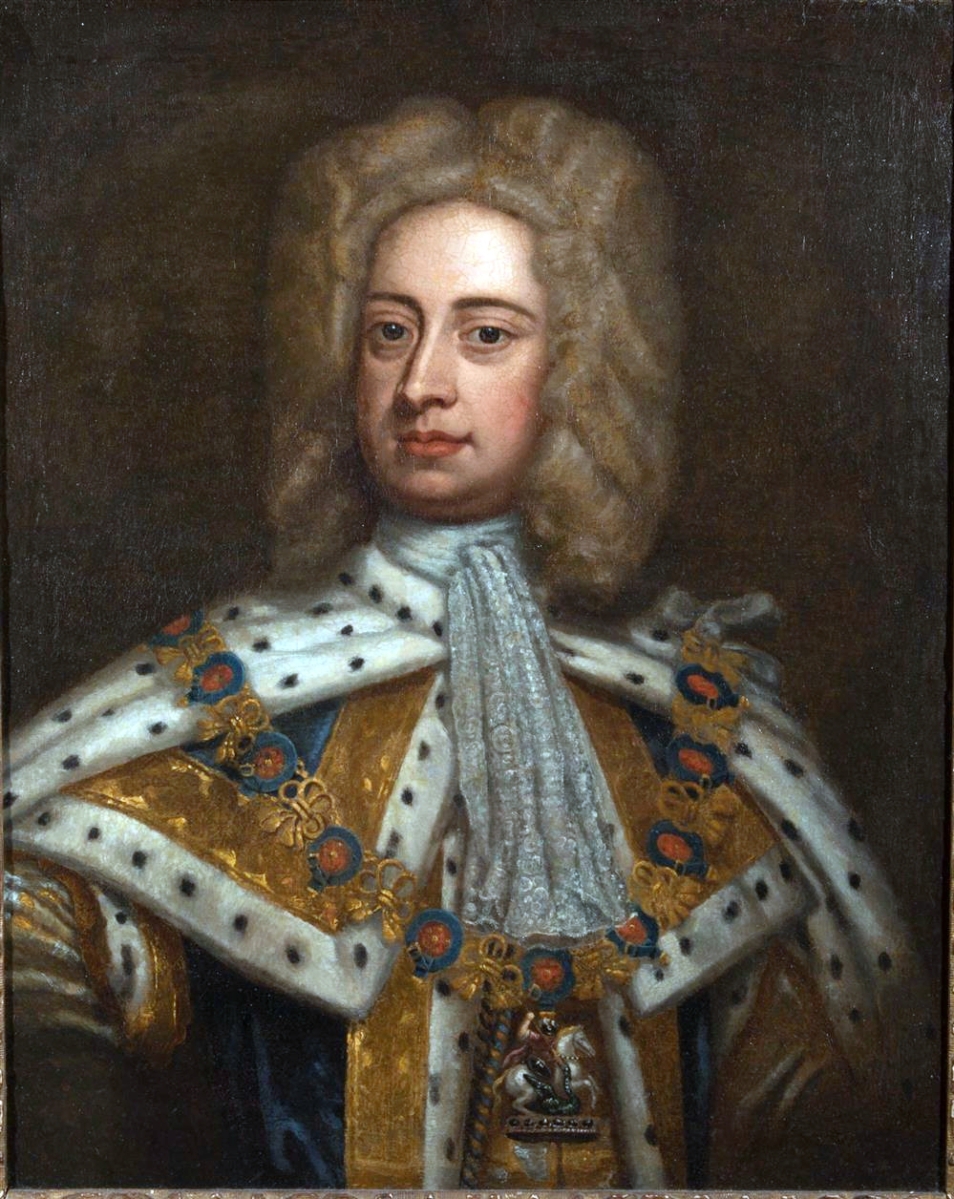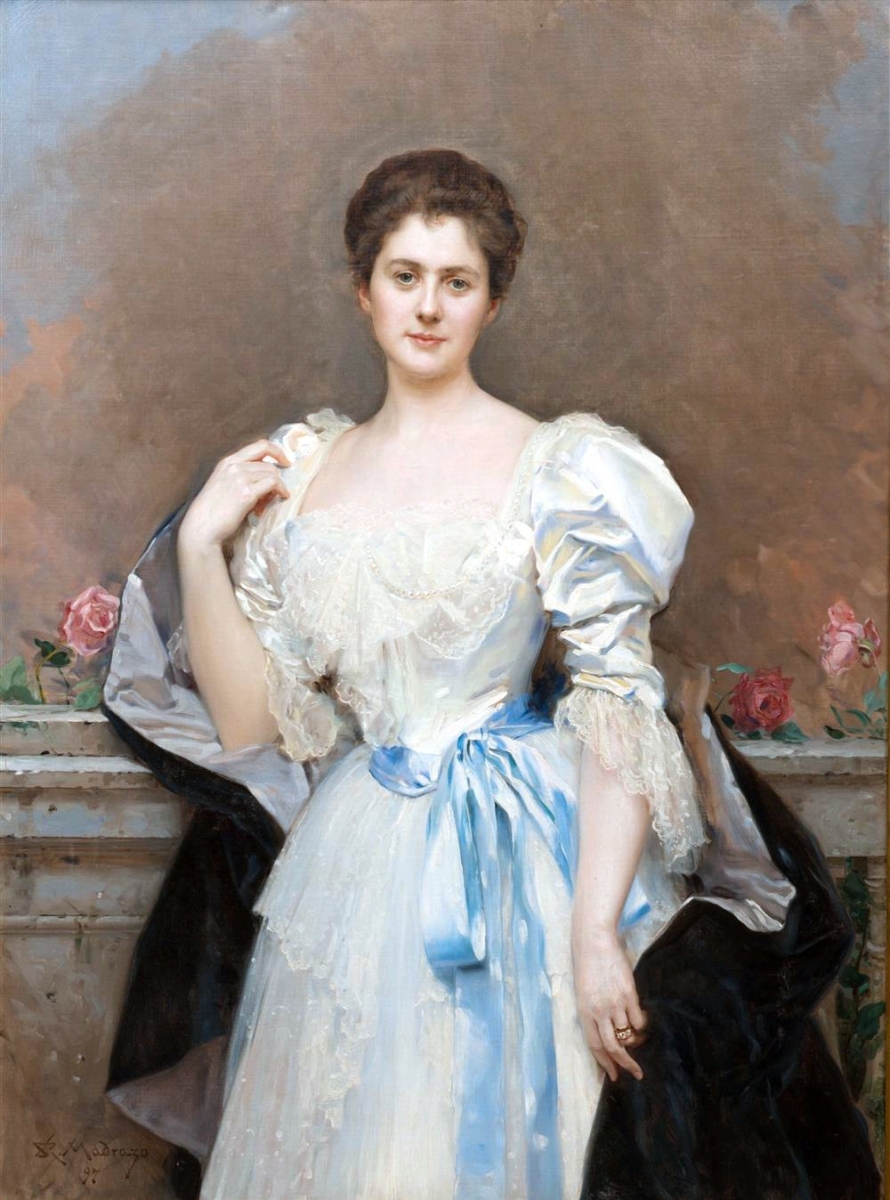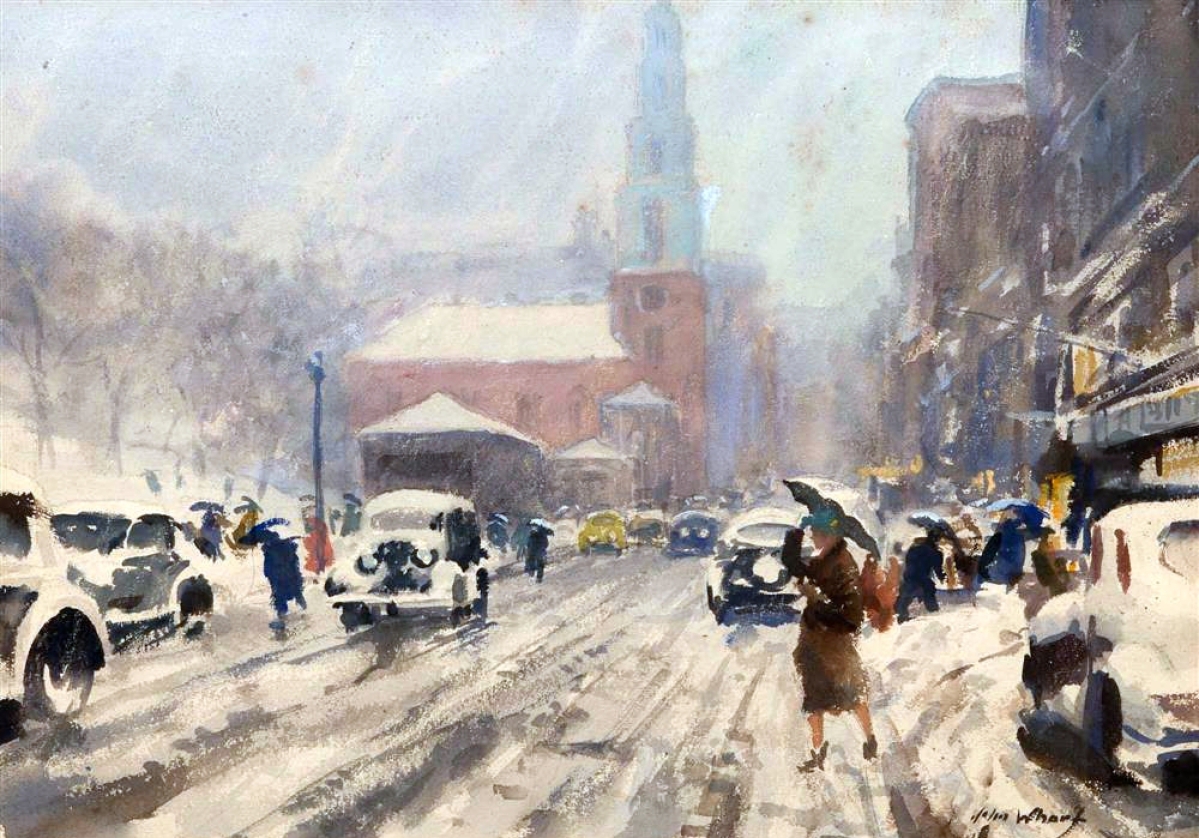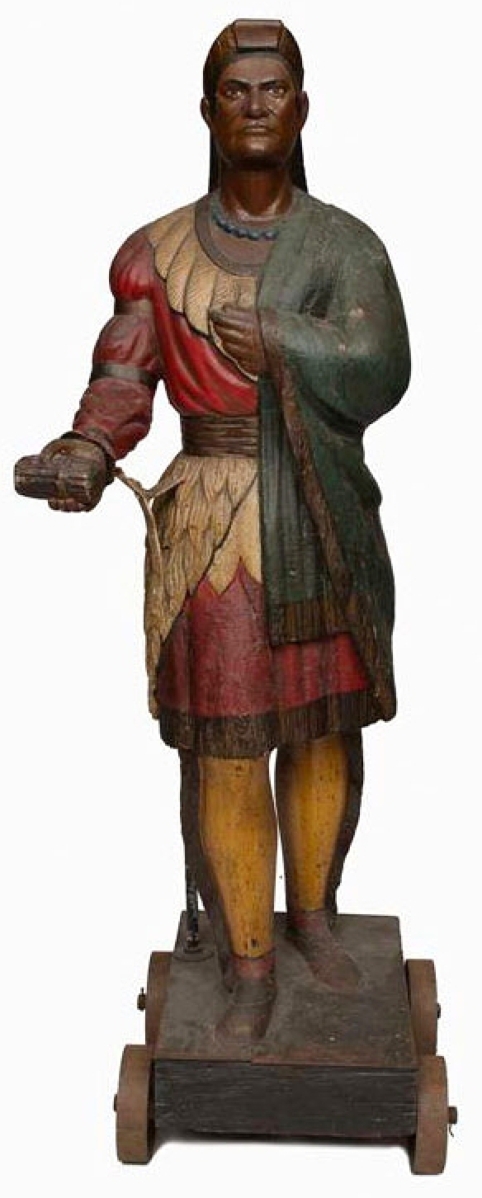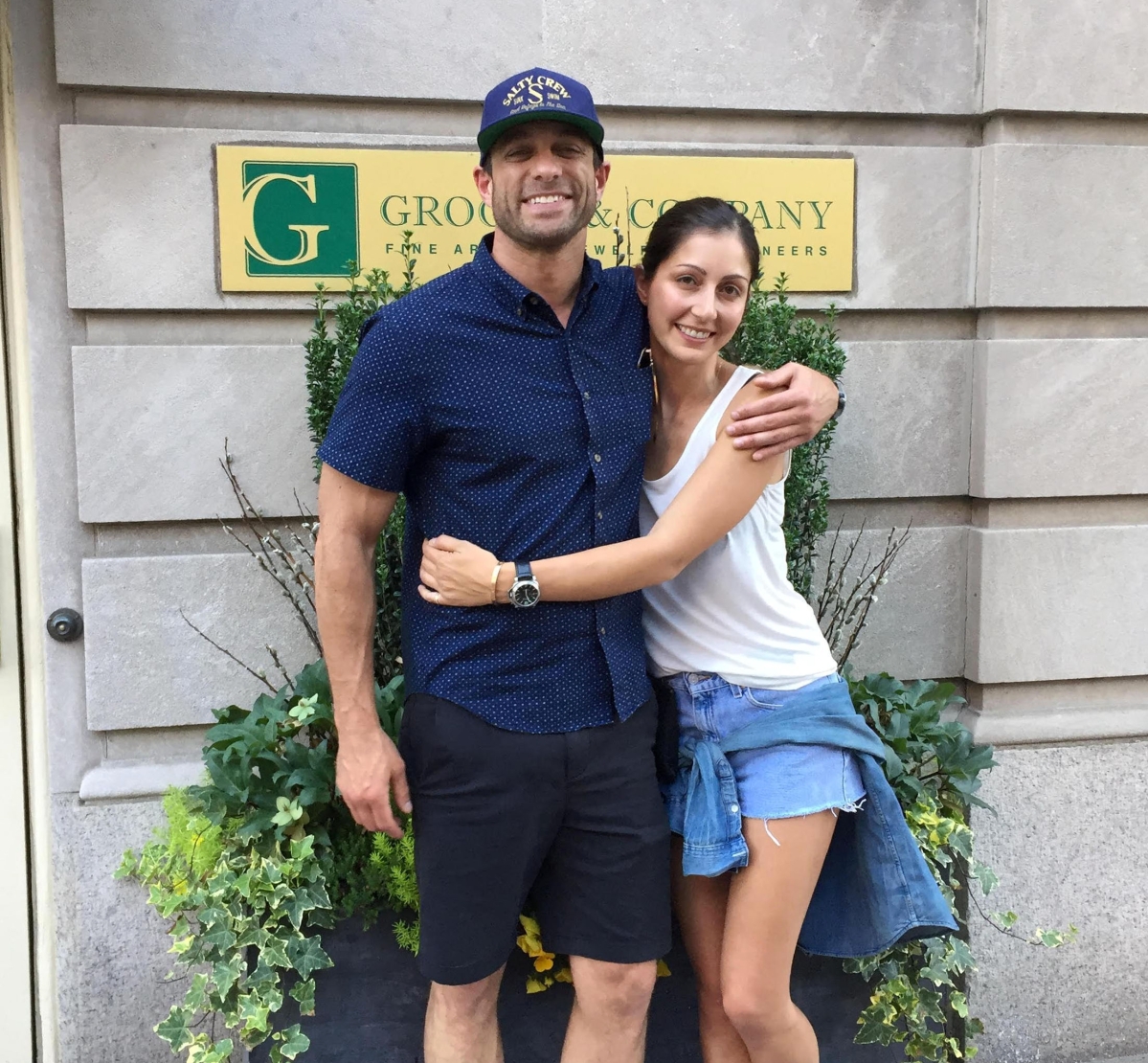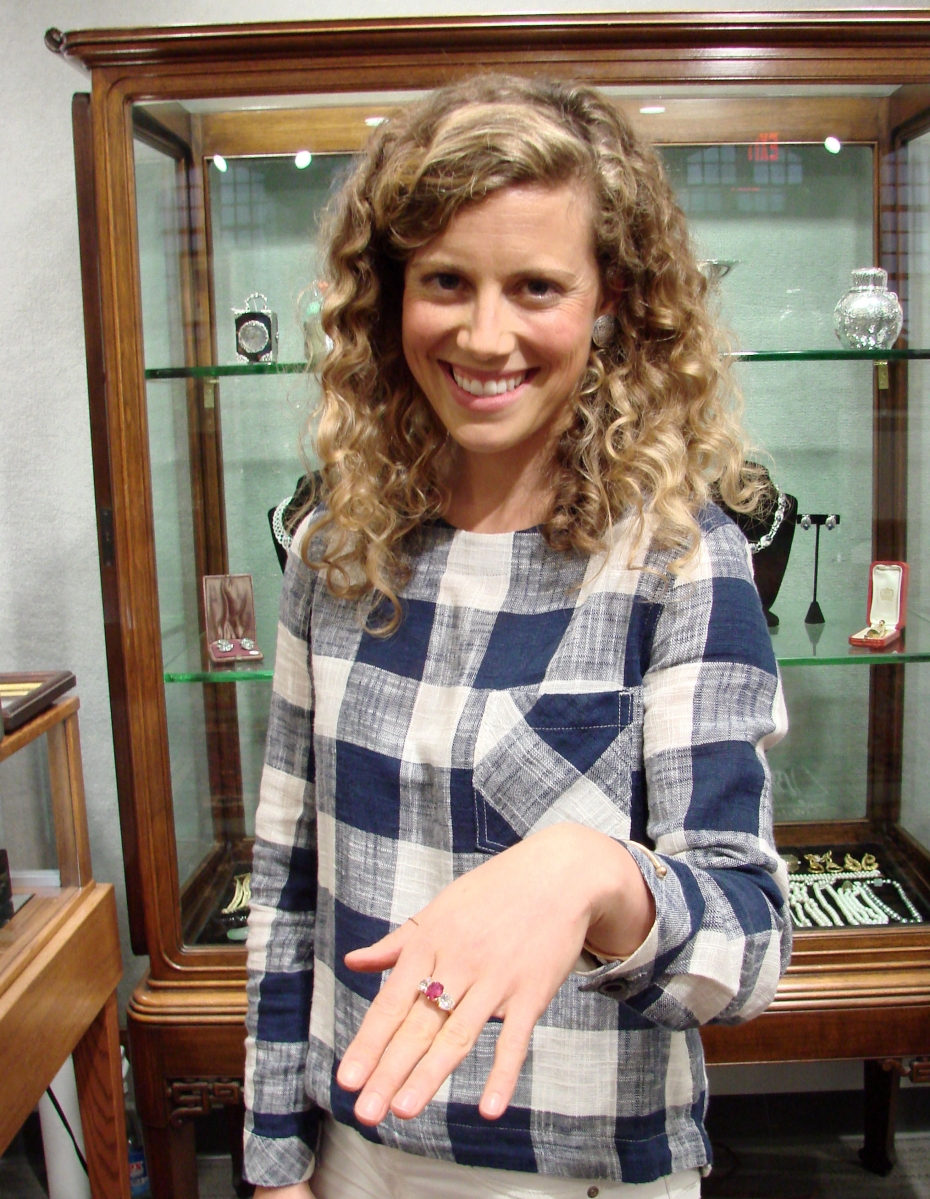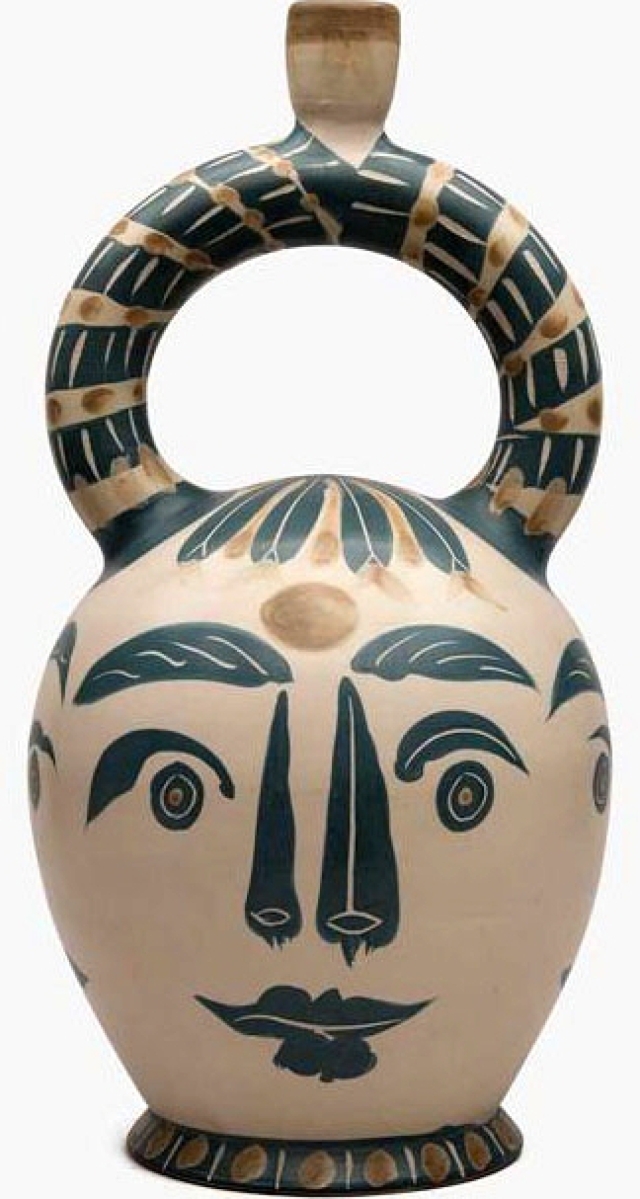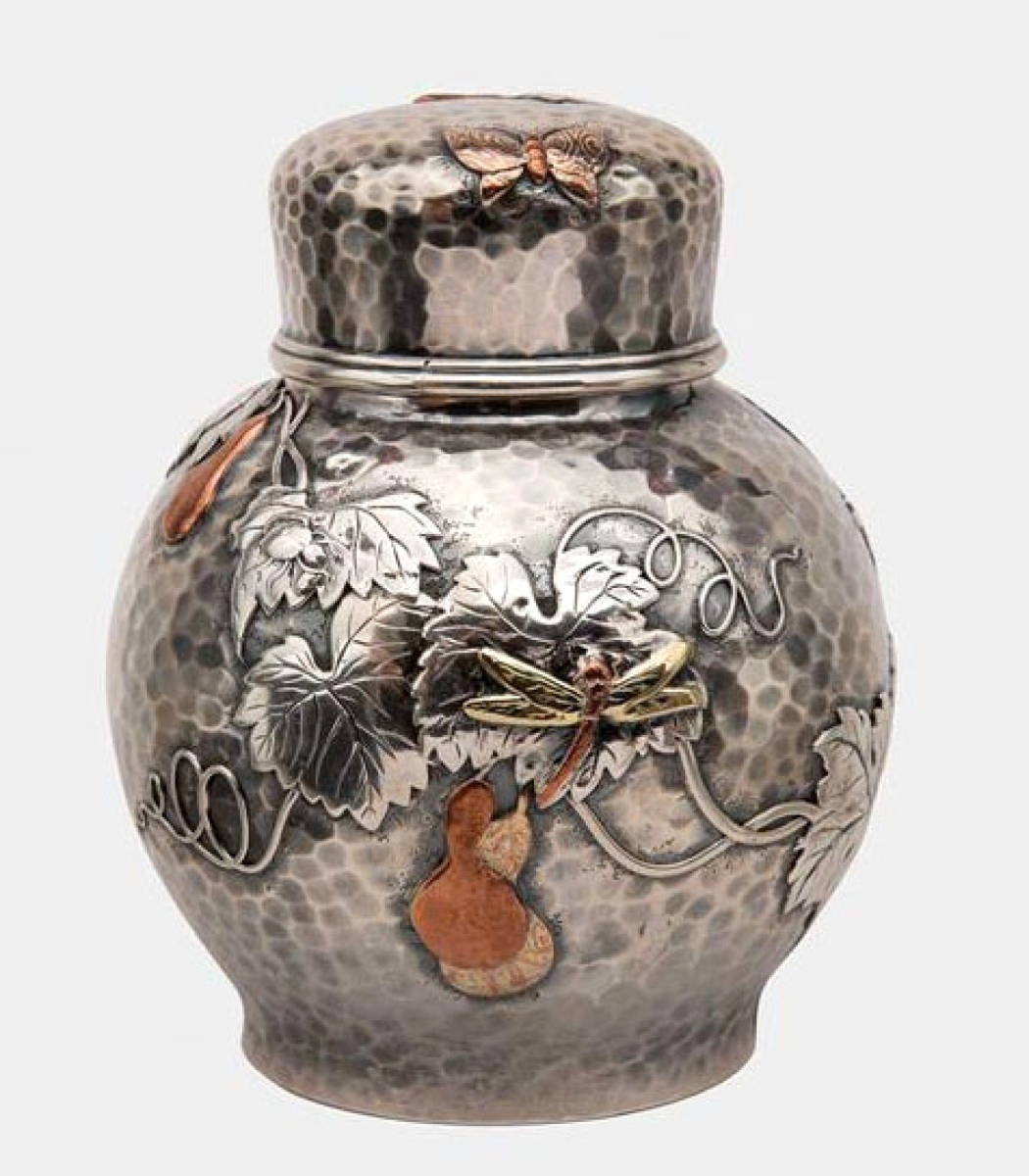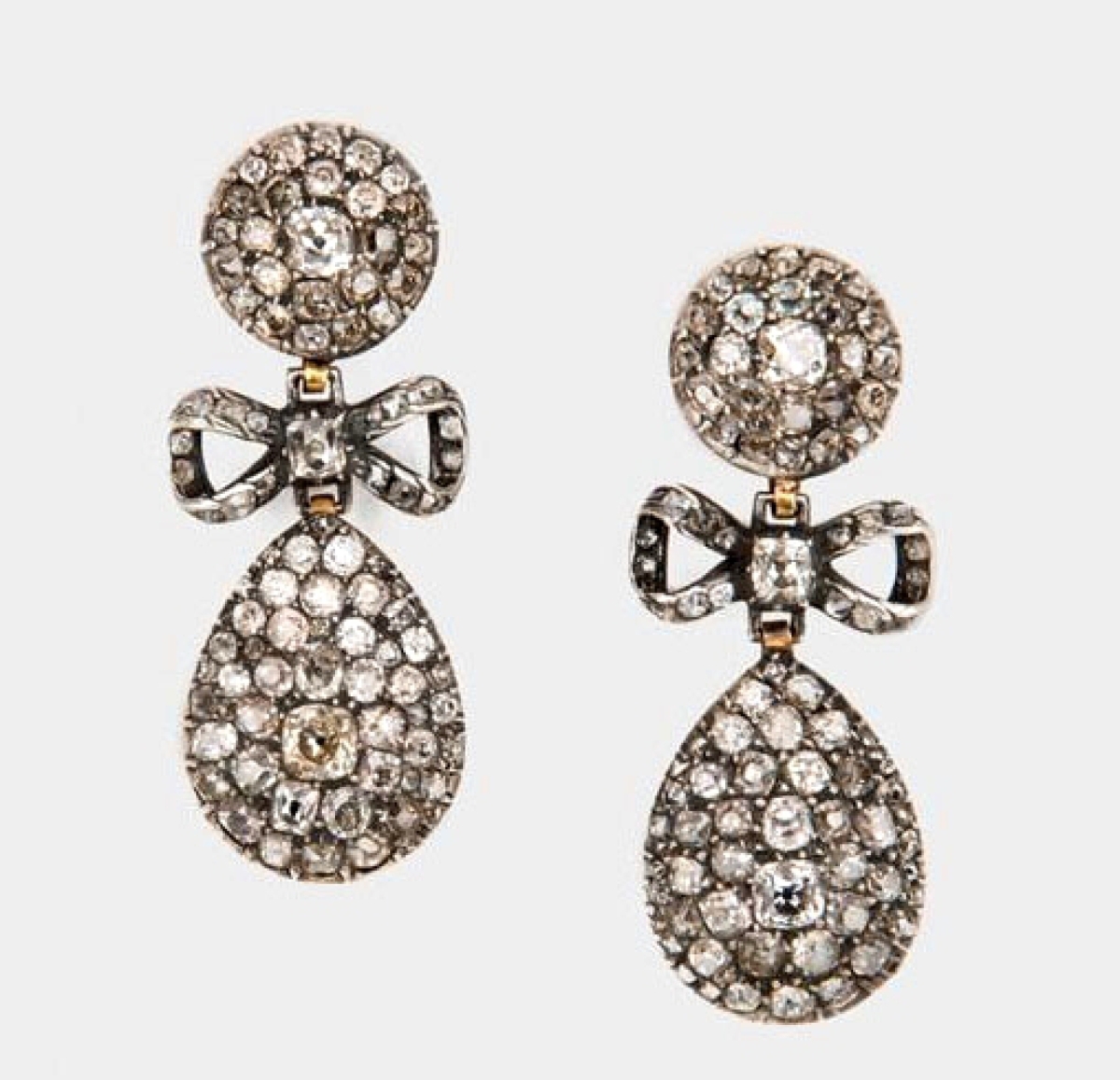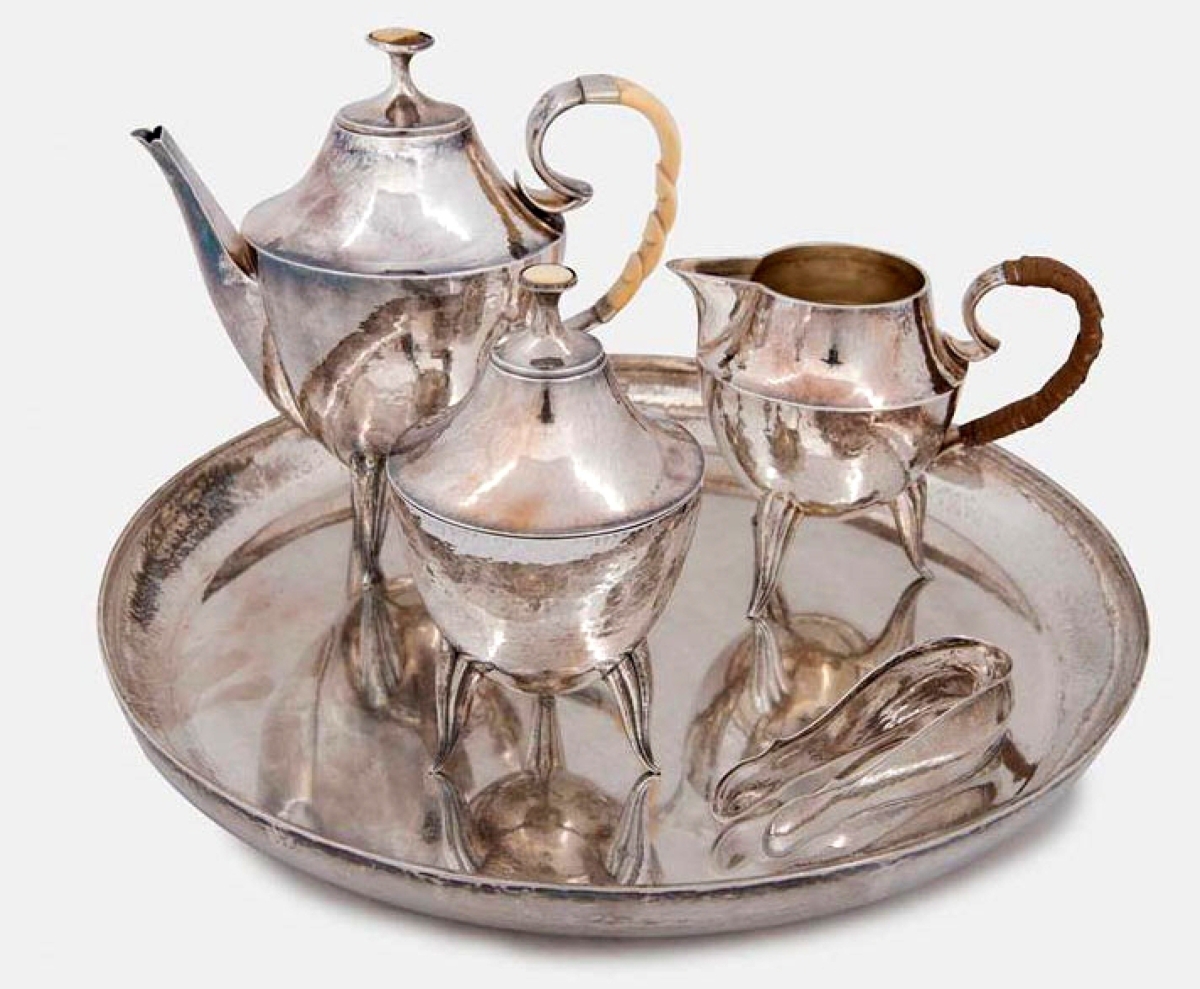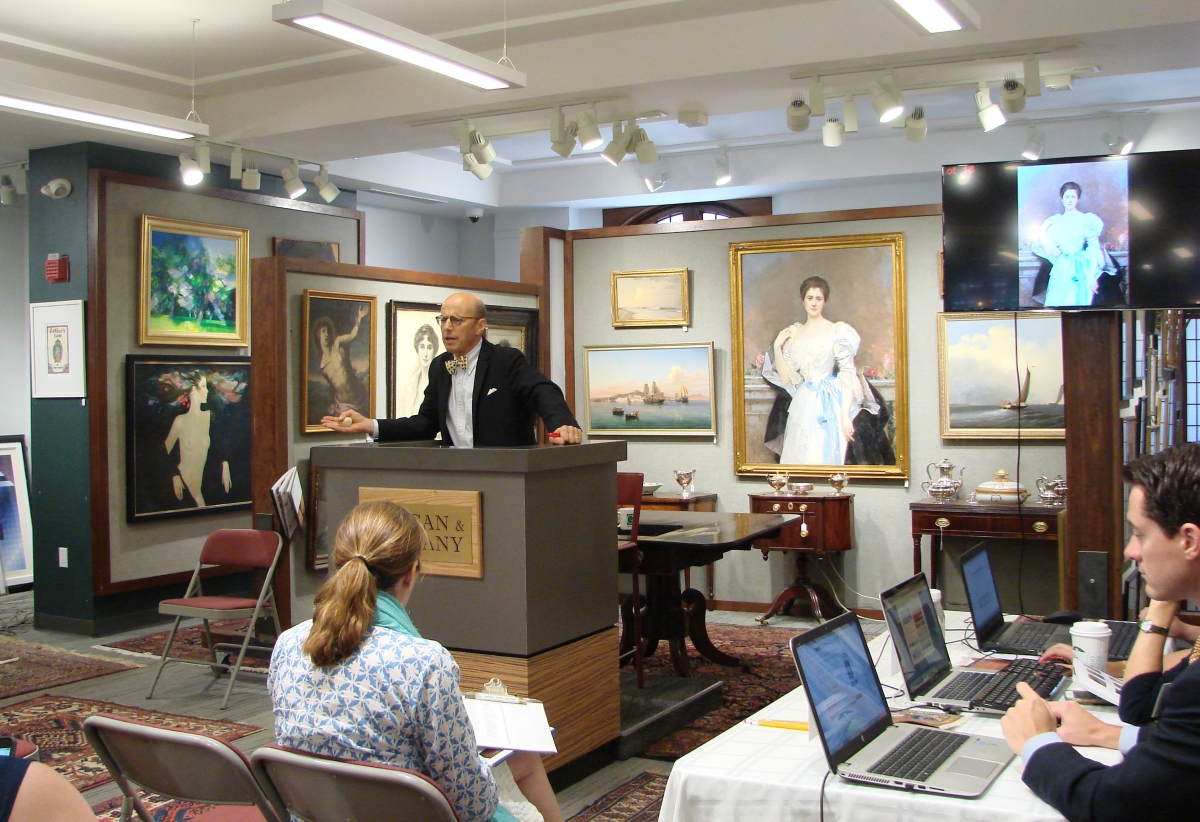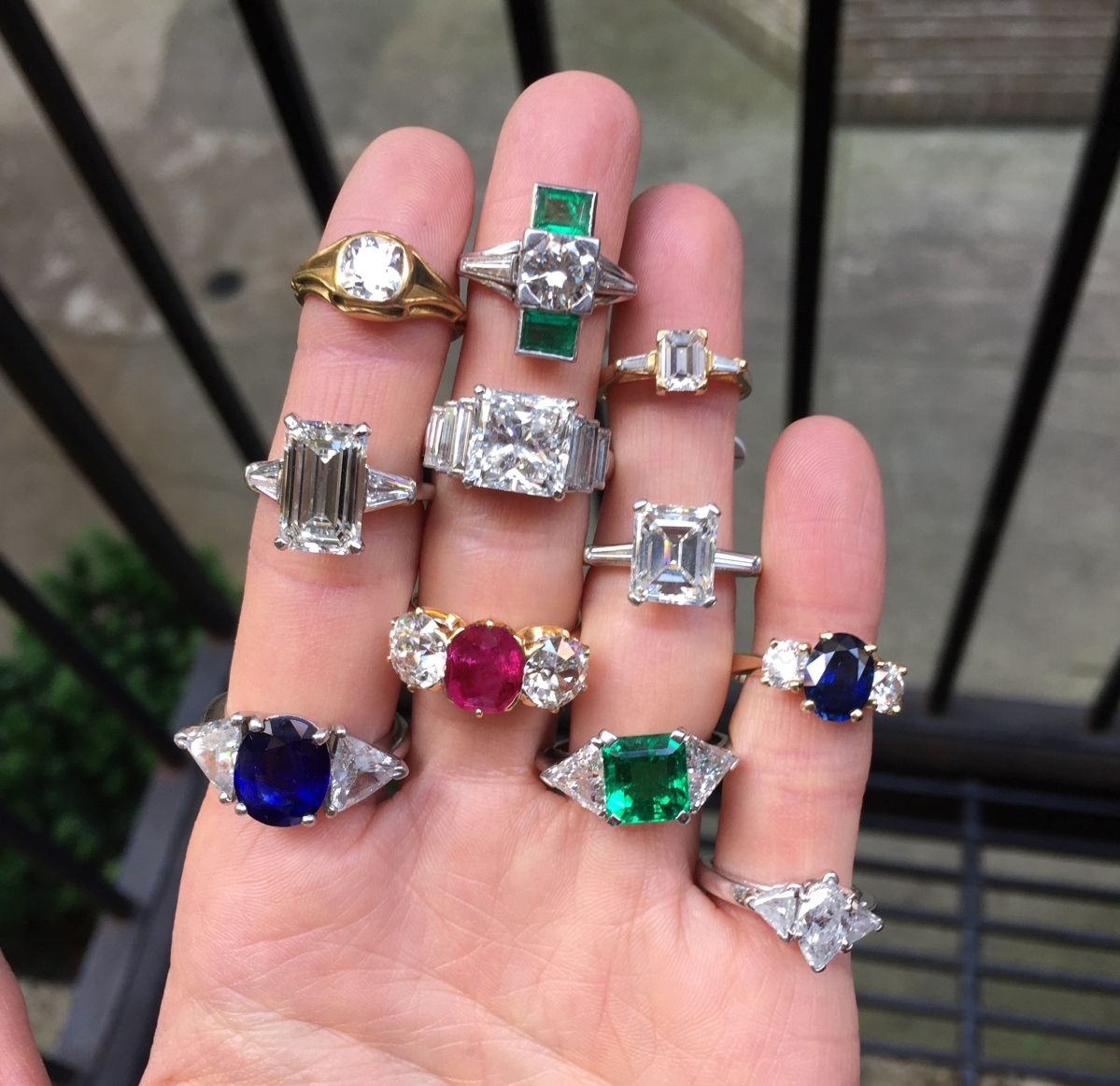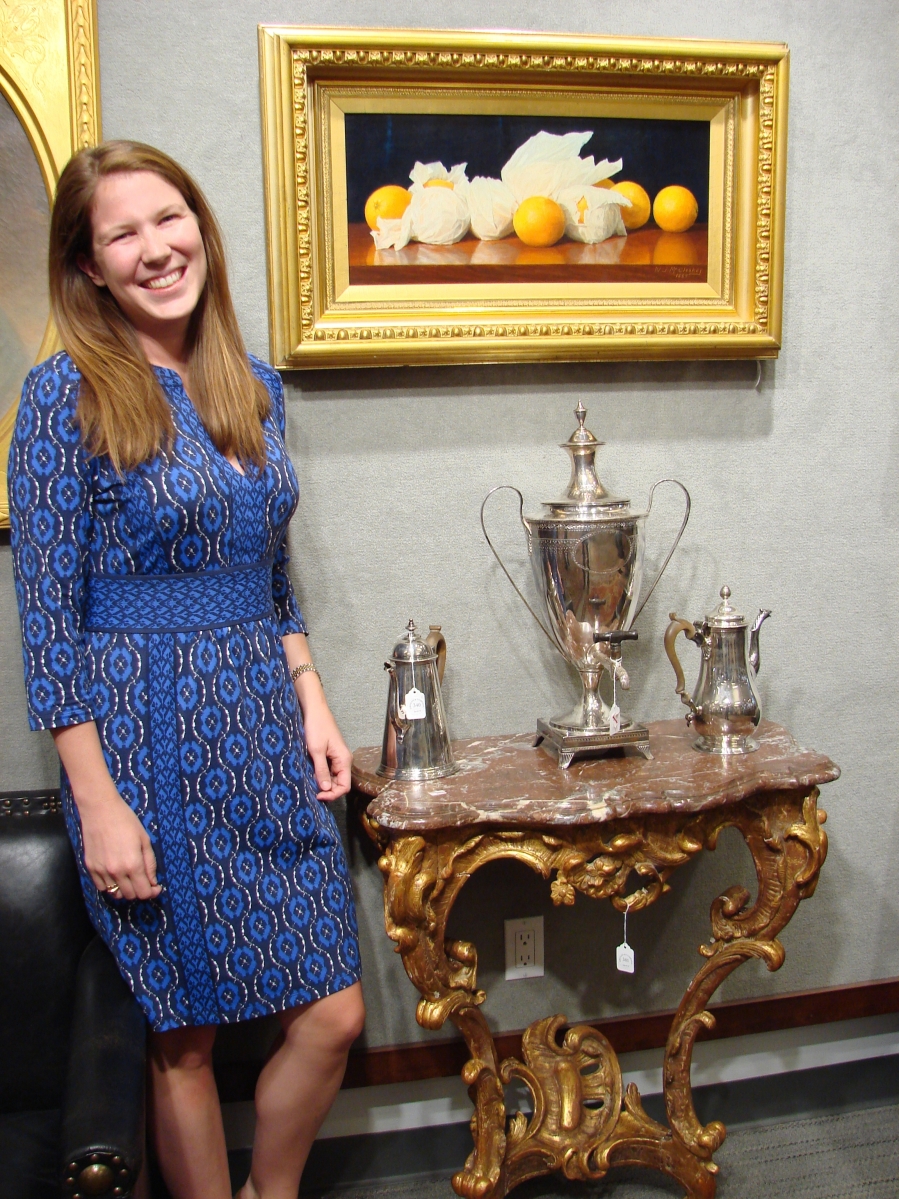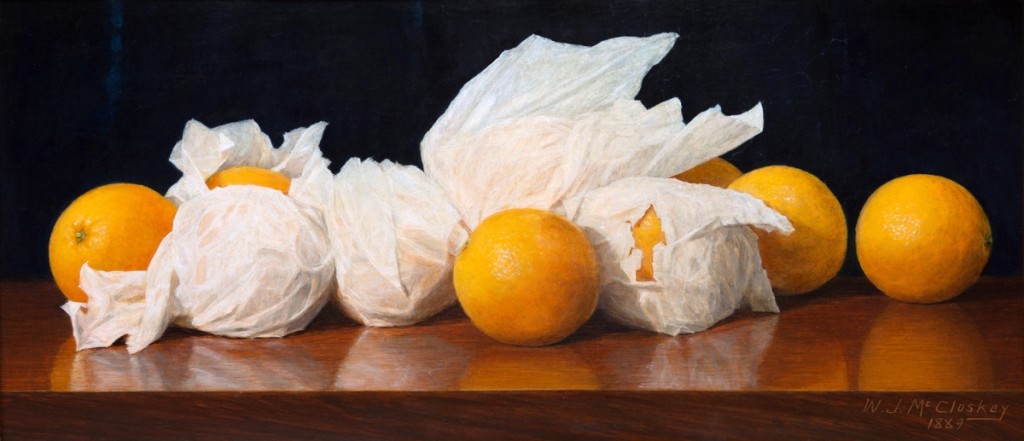
The top lot of the auction was one of William McCloskey’s renowned paintings of tissue-wrapped Valencia oranges. It brought $488,000.
Review and Onsite Photos by Rick Russack, Catalog Photos Courtesy Grogan & Co.
BOSTON – About 20 minutes into Grogan & Company’s June 11 sale you could see the sort of day it would be. An 1889 trompe l’oeil painting of tissue-wrapped Valencia oranges by William Joseph McCloskey (American, 1858-1941) more than tripled its estimate, finishing at $488,000.
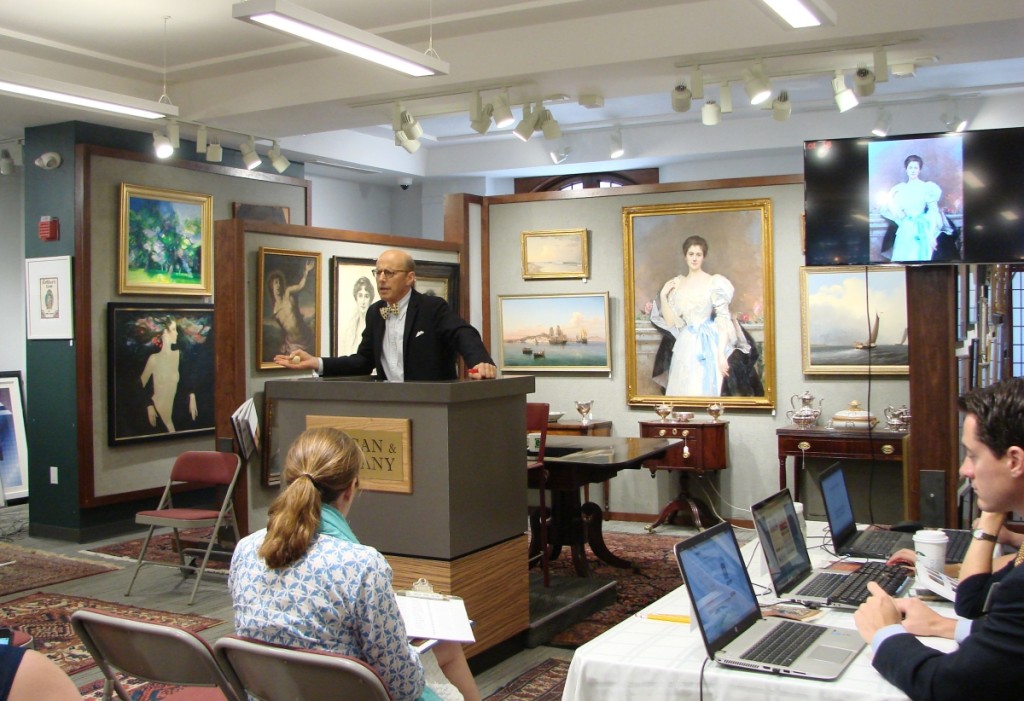
At the podium, Michael Grogan sells the large portrait of Mrs Oliver Gould Jennings, shown on the wall behind him.
Several other paintings also sold in five figures as well as a Picasso ceramic vase, which achieved $76,250. Also bringing more than estimate was a 40-inch bronze by Aristede Maillol, (French, 1869-1944) titled “Jeunesse,” which finished at $97,600. Several pieces of jewelry did well, with three rings, sold one after another, together totaling nearly $100,000. One other special diamond ring sold to a couple who had flown in from San Francisco specifically for the ring. It was to be the young lady’s engagement ring and they had found it on Instagram. The sale grossed $1,540,000.
William Joseph McCloskey and his wife, Alberta, were masters of still life paintings of fruit and William’s paintings of tissue-wrapped oranges, such as this one, are considered outstanding examples of his work, and highly sought-after. Paintings by the couple were the subject of a 1996 exhibit at the Bowers Museum of Cultural Art, Santa Ana, Calif., and a painting of Valencia oranges was included in that exhibit. Fewer than 100 of McCloskey’s works are known today, with most in the Bowers. In 1889, the year this work was completed, it was included in the First Fine Arts Exhibition of the Detroit International Fair. A catalog from that show accompanies the painting today. Six phone bidders pushed the final price to $488,000, more than three times over estimate.
The McCloskey was not the only painting to do well. Finishing at $23,180 was a large 1897 portrait of Mrs Oliver Gould Jennings by Raimundo De Madrazo Y Garetta (Spanish, 1841-1920). He painted portraits for wealthy American families, and has several works in the Metropolitan Museum of Art and other institutions. A detailed view of the Venetian Harbor by Eugene Isabey (French, 1803-1866) realized $18,300 and a 1920 interior scene, “Tapisseries Roses,” by Walter Gay (American, 1856-1937) ended up at $17,080. You did not have to spend more than a thousand dollars for a painting at this sale. An Eighteenth Century portrait of King George II was had for $976 and a pastel portrait of Marie Antoinette was bought for $671.
The researching and cataloging of paintings is done by Georgina Winthrop, Grogan’s gallery manager and fine arts specialist. She is a descendant of John Winthrop, a founder and governor of the Massachusetts Bay colony. She has a bachelor’s degree in art history from Harvard and has worked for Grogan since graduating in 2014. She’s 26 and married last fall.
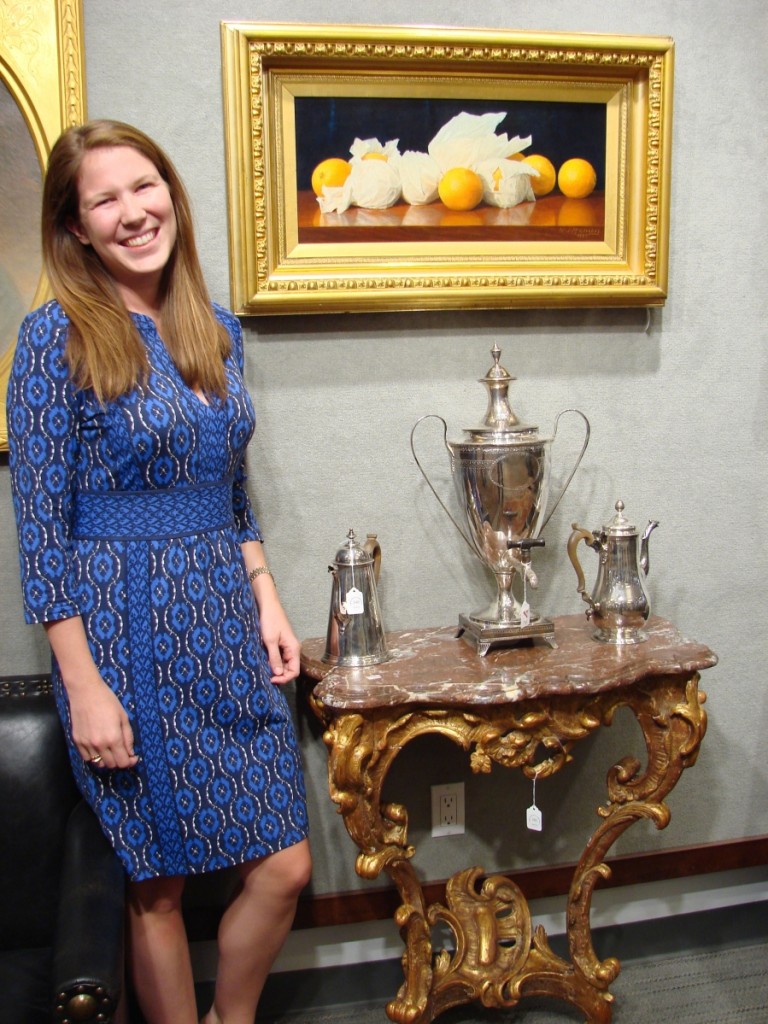
Georgina Winthrop, Grogan’s gallery manager and fine arts specialist, has been working for the company since graduating from Harvard with a bachelor’s degree in art history in 2014.
Winthrop discussed her work with Antiques and The Arts Weekly. “I grew up in the Boston area and I wanted to stay in the area after graduating. I had interned at Sotheby’s and the Gardner Museum and I liked the buying and selling part of the business. When I heard that Michael Grogan was moving his business to Boston, I called him, asked about a job and he hired me. I was the auction coordinator at first, not doing the cataloging but that became my job and that’s when I really started to learn.”
“Very little of the type of art that we studied at Harvard turns up on the auction market. I wish they taught us more about the types of paintings that are collected today. Researching and dealing with the wide variety of paintings that we get here has really expanded my knowledge. And since Grogan’s is not the size of a Sotheby’s or Christie’s, I’m able to be involved in all aspects of the business. I go out on house calls with Michael or Lucy and sometimes by myself, deciding what we can most likely sell. So I get to deal closely with both consignors and buyers, as well as those clients asking for more information about paintings they see in our catalog.”
“I’d never have that level of responsibility in one of the larger auction houses. I do the catalog descriptions, research the paintings, lay out the catalog, do the advertising, etc. Part of the cataloging includes describing condition, so I use blacklight along with what I learned in school. I’d hope that someday I could devote more of my time to researching. For myself, I collect works on paper; things like etchings by Whistler. I’ve done a lot of traveling in Italy, especially to Venice, and I’ve also been to Greece. Sometimes, it was part of the Harvard studies and sometimes with friends.” Michael Grogan added, “She’s a real asset to our business.”
Fine jewelry usually comprises about half of Grogan’s sales and it did this time, led by a platinum and diamond ring. The 5.01-carat, cut-cornered, brilliant-cut diamond was flanked by six bezel-set baguettes weighing approximately 1.6 carats. It was GIA-certified as G VS1 with no fluorescence and it realized $68,320. Another platinum and diamond ring earned $30,500. The prong-set emerald cut diamond weighed 3.7 carats and was also accompanied by GIA certification. A rare pair of Georgian silver and diamond pendeloque ear pendants, dating to the late Eighteenth Century, and described on the inside back cover of the catalog, realized $13,420.
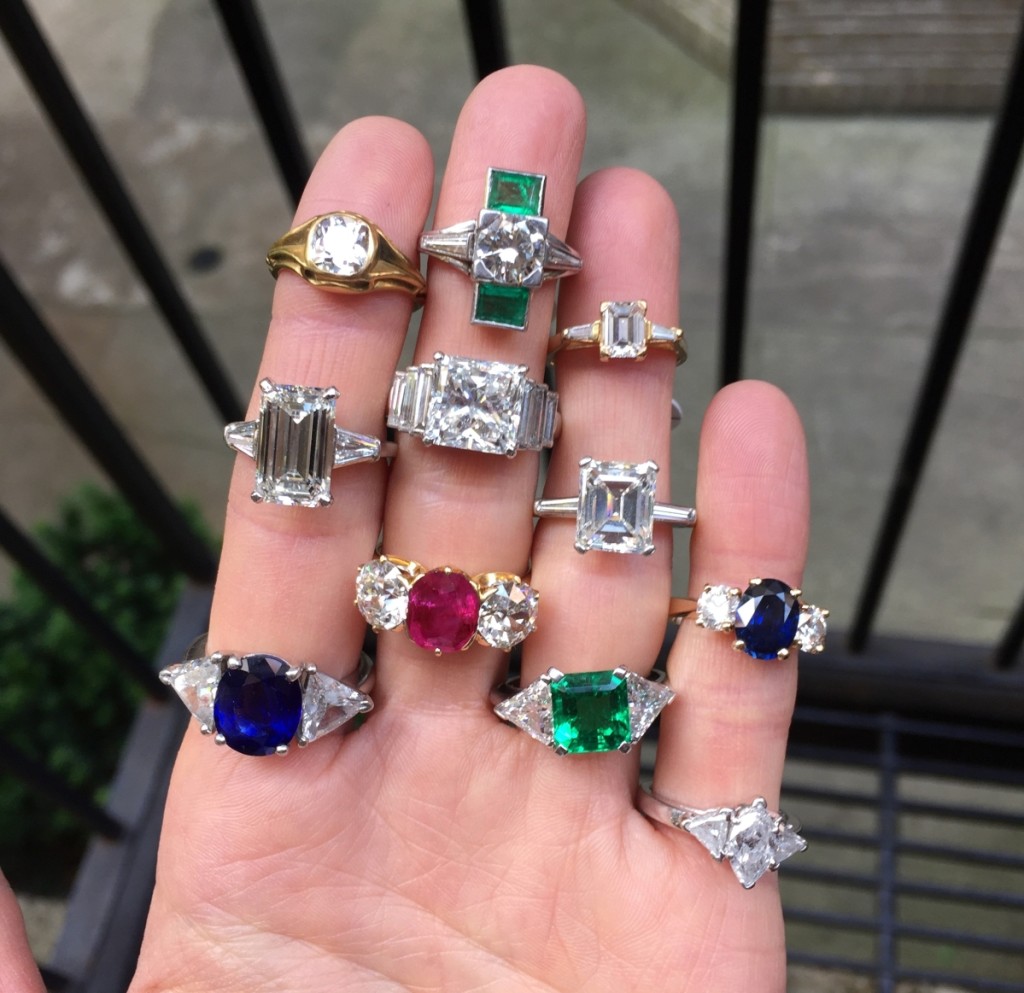
This is one of the Instagram photos that caught the eye of the couple from San Francisco. Eleven rings are shown and one of the hash tags is “handparty” and another is “fingerparty.” Lucy Grogan has been promoting jewelry sales on Instagram for about a year and says, “It works.”
The best story connected with the jewelry portion of the auction was about another platinum and diamond ring. This was a special one; a circa 1920 ring with an emerald-cut diamond weighing approximately 3½ carats, which sold for $27,450. It was bought by one half of a millennial-age couple in the room and you could tell it was to be an engagement ring. When asked, Erik Altman, the buyer, confirmed that he had bought it as an engagement ring for the young lady with him, Natasha Sadeghi. They had come from San Francisco specifically for the ring, having seen it on Instagram. Altman said, “We’ve been looking for over four months for a vintage diamond. We found some resources online but after learning more about diamonds we realized that paying retail was a mistake. So we started looking at estate auctions. The first one we found was Grogan’s but then looked at many other resources and finally ended up back at Grogan’s for the win. We knew we had to touch the diamond before buying it and since we both have lived in, and love Boston, we threw caution to the wind and came on out. This was our first auction ever. We still can’t believe we got the ring. And we love the Grogan family. So nice and accommodating. Great experience and I think we’re going to look to auctions to buy art for our house now!” In the photograph of the couple, Natasha is not wearing the ring. “Bad luck to put the ring on before I propose!” Altman quipped. It’s probably safe to assume that by now, she’s wearing the ring.
The Instagram connection is not unusual for Grogan. The day after the sale, Lucy Grogan, vice president and head of Grogan’s jewelry department, noted she has been using Instagram to promote jewelry sales for about a year. She has more than 2,000 followers. “Instagram is a great place to attract jewelry buyers and it’s fun. I use the name “lucyontheroadwithdiamonds” and hash tags to make the listings easy to find. I know it’s resulted in many more people checking our online listings, we’ve gotten several inquiries, and there have certainly been sales, like the engagement ring Erik bought for Natasha. Millennials are comfortable buying things they’ve seen online. It works.”
Michael Grogan summed up the sale. “With the top 20 lots, it was like the good old days. Other material did well, and anytime we can do more than a million and a half dollars, it was a good sale.” That seems to say it all.
All prices reported include the buyer’s premium.
For additional information, www.groganco.com or 617-720-2020.

